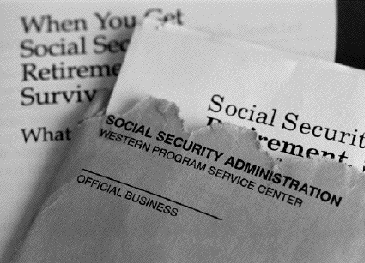
|
| Briefing Book |
| Background Material |

|
| Briefing Book |
| Background Material |
| How Social Security Works. |

Social Security is a social insurance program. It pays retirement benefits to workers and their spouses, disability benefits to those who cannot work and members of their families, and survivors' benefits to the families of workers who have died.
147 million workers, and their employers, pay taxes on wages. The tax is 6.2% for the worker and an identical amount for the employer, on salaries up to $68, 400 in 1998. The Medicare tax, 1.45% paid by worker and employer, is levied on all salary income.
The money collected from payroll taxes goes to pay monthly benefits to 43.9 million beneficiaries (March, 1998).
These include:
Social Security paid out about $367 billion in benefits last year, the
biggest single federal expenditure, and 20% of the total federal
budget.

Social Security is essentially a "pay-as-you-go" system, with today's workers paying the bill for their parents and grandparents who are receiving benefits now. You do not have a separate account for your money, as in some private pension plans, where money is set aside for each worker. Instead, you the worker have a promise by the nation's political system that you will get a benefit during retirement. The money will come from taxing the wages of your children and grandchildren.
When Social Security was created in 1935, President Roosevelt spoke of the three-legged stool for retirement security. It would include pensions, savings and Social Security. For most people, however, the main source of retirement income is Social Security.
For two-thirds of people receiving Social Security, the monthly check supplies 50% or more of their income. Among couples over 65, a whopping 91% have Social Security income, but only 42% have other retirement benefits.
The elderly are protected against inflation by the annual
cost-of-living adjustment (COLA) in Social Security benefits. The COLA
goes up by the amount of increase in the federal Consumer Price Index
each year. Private pensions are rarely increased for inflation.
Therefore, the longer people live, the more dependent they become on
Social Security. There are thousands of widows over age 80 who have
outlived their savings, and whose pensions have dwindled with time and
inflation. Social Security is their defense against destitution.

You need 10 years of work to qualify for benefits. The size of the monthly check is linked to earnings during your working career. But the complex formulas are arranged to give proportionately more money to low-income workers.
The average person, someone who earned about $27,000 in 1997, will get a benefit at age 65 equal to about 42% of his or her earnings. The worker at the current maximum wage base, $68,400, will get a monthly check, representing about 26% of his or her wages.
You can retire at age 62 and receive 80% of the benefit, or wait until age 65 and get 100% of your benefit amount. Most people today retire before age 65.
(Retirement age will be boosted for the baby boomers, starting in the next century. The age for full retirement benefits will rise to 66 for those born 1943-54, and gradually increase to age 67 for those born in 1960 or later.)
Some current figures, as of January 1998:
The aging of the baby boomers, those Americans born in the years 1946 through 1964, will create severe financial pressures on the Social Security system. This is the largest generation in American history, 76 million. They married late and had relatively few children. Their kids will have a heavy burden of Social Security taxes.
The trust funds will face a financial crisis in the year 2032, when, according to intermediate estimates of the Social Security Board of Trustees, their balance is exhausted, and there will be enough current revenue to pay just 75% of the promised benefits.
The choices are unattractive: raise taxes to produce more revenue for the trust fund, cut benefits, or else do a bit of both.
This is the core of the debate that will engage the American people.
How do we manage the financial burden imposed by an aging population,
supported by a small work force?
| Program | Employer and Employee (each) | Self-Employed |
| Total | 7.65% | 15.30% |
| Old Age & Survivors' Insurance (OASI) | 5.35% | 10.70% |
| Disability Insurance (DI) | 0.85% | 1.70% |
| Hospital Insurance (HI) | 1.45% | 2.90% |
| Social Security tax for employers and self-employed can be partially offset under income | ||
| 1996 | $ 25,914 |
| 1997 | $ 27,019 |
| 1998 (est.) | $ 27,895 |
| Office of the Chief Actuary, Social Security Administration | |
| Old Age Survivors' & Disability Insurance (OASDI) | $ 68,400 |
| Hospital Insurance (HI) | No limit |
| Earner | OASI | DI | HI |
| Average Earner (est.) | $ 1,467 | $ 262 | $ 404 |
| Maximum Earner | $ 3,598 | $ 643 | No limit |
| Self-employed maximum earner | $ 7,196 | $1,286 | No limit |
| Quarters of Coverage --- Work Credits (1998) |
| $700 in earnings equal one quarter of coverage (or 1 credit) |
| $2,800 are maximum earnings needed for four quarters of coverage (or 4 credits) per year |
| Age | Annually | Monthly |
| Age 65-69 ($1 for $3 withholding rate) | $ 14,500 | $1,208 |
| Under age 65 ($1 for $2 withholding rate) | 9,120 | 760 |
 |
 |
 |
 |
 |